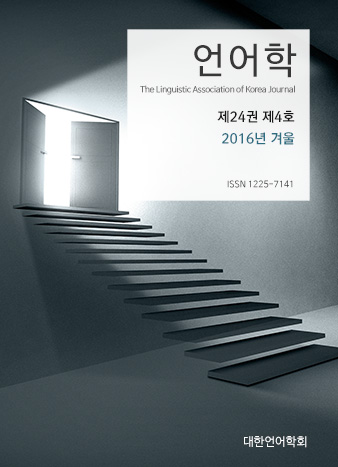대한언어학회 전자저널

-
An Alternative Approach to Realizations of the Medial [nt] Cluster in English
-
Boundary and pitch effects on the perception of Korean alveolar nasal
-
Corpus-Based English Grammar Instruction in a Korean College Context Korean College Context
-
A Study on the Relationship between Self-Efficacy Beliefs and Comprehension in English Reading
24권 4호 (2016년 12월)
Abstract
Keywords
# scalar entailment # scalar implicature # metalinguistic negation # Maxim of Quantity # Principle of Politeness # Horn’s scale # Matsumoto’s scale # pragmatic constraint by the same criterion
References
- Brown, P. & Levinson, S. (1987). Politeness: Some universals in language use. Cambridge: Cambridge University Press.
- Gazdar, G. (1979). Pragmatics: Implicature, Presupposition, and Logical From. London: Academic Press.
- Grice, H. P. (1975). Logic and Conversation. In Martinich, Aloysius P. (ed.) The Philosophy of Language (third edition). Oxford: Oxford University Press. 156-167.
- Hirschberg, J. (1985). A Theory of Scalar Implicature. Ph.D. dissertation. University of Pennsylvania.
- Horn, L. (1985). Metalinguistic Negation and Pragmatic Ambiguity. In Language 61: 121-174.
- Horn, L. (1989). A Natural History of Negation. Chicago: The University of Chicago Press.
- Horn, L. (2004). Implicature. In Horn, Laurence R. and Ward, Gregory (eds.), The Handbook of Pragmatics. Oxford: Blackwell. 3-28.
- Huang, Y. (2007). Pragmatics. Oxford: Oxford University Press.
- Lee, Sungbom. (2001). Churoneui Whayongron [Pragmatics of Inference]. Seoul: Hankuk Munhwa-sa.
- Lee, Sungbom. (2002). Yeong-eh Whayongron [English Pragmatics]. Seoul: Hanhuk Munhwasa.
- Leech, G. (1983). Principles of Pragmatics. New York: Longman.
- Levinson, S. (1983). Pragmatics. Cambridge: Cambridge University Press.
- Levinson, S. (2000). Presumptive Meanings: The Theory of Generalized Conversational Implicature. Cambridge: MIT Press.
- Matsumoto, Y. (1995). The Conversational Condition on Horn Scale. In Linguistics & Philosophy 18: 21-60.
- Schegloff, E. (1971). Notes on a Conversational Practice: Formulating Place. In D. Sudnow (ed.). Studies in Social Interaction. New York: Free Press. 71-119.